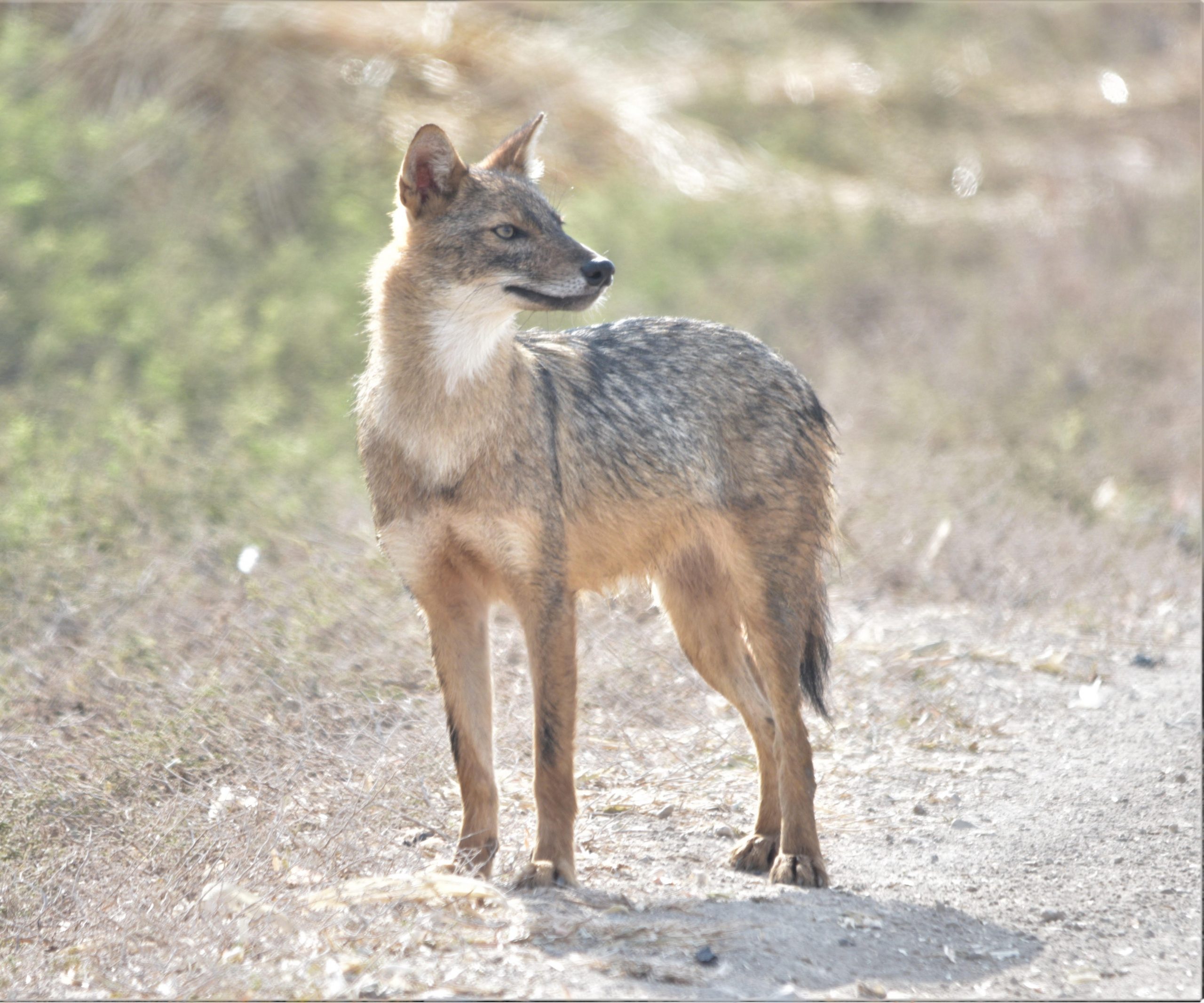Golden Jackal, תן, Canis aureus
Back to FaunaImage gallery
Biblical data
Introduction
The תן can be found fourteen times in the Hebrew Bible.[1] In all these occurrences, the תן appears in a plural form (תנם, תנת.) The תן largely appears within prophetic texts in contexts of divine statements of judgement (twelve times) and, within these occurrences, eight refer to the animal’s habitation (מקום, נוה, מעון). Often, the תן is also employed as part of a metaphor or simile.
Furthermore, the תן often appears paralleled with other animals of the wilderness. The most common parallel is with the בנות יענה (ostriches or owls?) which occurs alongside תן five times. In Isa 13:21–22, the תן also parallels ציים (beasts?), אחים (owls?), שעירים (goat or demon?), איים (hyenas?).
As indicated within the History of Identification discussion, the attempted identification of the תן has been somewhat complex. Generally, the תן has been assumed to refer to the golden jackal (Canis aureus), suggested by its description as living in the wilderness, dwelling in ruins, and its vocal cry. An alternate suggestion is to identify the תן as a subspecies of the Eurasian eagle-owl, (either Bubo bubo desertum or Bubo bubo interpositus; see: Aharoni, 1938, 469–470; and Feliks, 1981, 101–102), however this seems particularly unlikely due to specific mammalian behaviour demonstrated in Lam (4:3, qere). The golden jackal is therefore perhaps the most likely candidate, despite its possible identification with the שׁועל too.
Distribution within the Bible
Eleven of the fourteen references to תן appear in prophetic texts. Four of these are in the book of Isaiah where they appear in prophetic judgements against other nations (Isa 13:22, 34:13), as well as descriptions of future blessings (Isa 35:7, and 43:20).[2] There are five appearances in the book of Jeremiah in which they are found in descriptions of desolation in either the present (Jer 14:6) or future (Jer 9:10, 10:22, 49:33, and 51:37). In Micah (1:8) תן is associated with mourning after a judgement upon Samaria and Jerusalem (Mic 1:8). The only occurrence of the feminine plural form תנות is in Malachi (1:3) which also describes desolation of the country.
Additionally, תן occurs twice in poetry (Ps 44:20; Lam 4:3, qere) and once in wisdom literature (Job 30:29).
Parts, Elements, Features that Are Specified in the Bible
Habitat. The תן is often associated with its habitat and is described as dwelling within desolate areas (Isa 43:20), or regions uninhabited by humans (Isa 13:22). In Malachi (1:3) the תן is explicitly said to live in the “wilderness” or “desert” (מדבר). Furthermore, the close link between תן and this wilderness environment is apparent due to the fact that desolate regions are often called either “the place” (מקום; Ps 44:20), “abode” (נוה; Isa 34:13, 35:7), or “lair” (מעון; Jer 9:10, 10:22, 49:33, 51:37) of jackals. Their habitat also seems to be characterised by the lack of available water (Isa 35:7), and the prevalence of prickly or thorny plants (Isa 34:13).
Vocal cry. The most common behaviour connected with the תן is its vocalisation. They are described as howling (Isa 13:22) and wailing (Mic 1:8) within the wilderness. Job also describes himself as a brother to jackals (Job 30:29), seemingly on account of his activity in crying out for help (Job 30:28). It is also possible that the honour given by the תנים in Isa 43:20 should be understood as a vocalisation (Atkins 2020, 508).
Panting. The תן is also associated with the act of panting, which they seem to do when they are lacking food and water (Jer 14:6). The context, and the fact that their habitat is typified by a general lack of water (Isa 35:7), suggests this might be the principal cause of such behaviour.
Maternal behaviour. Lam 4:3 (qere) indicates the maternal role of the תן in raising young by nursing them with their mother’s milk. Interestingly, while there is an attested feminine plural form of תן (תנות; Mal 1:3), Lam 4:3 uses the masculine plural form (תנים) when describing this maternal behaviour.
Function in Context
All the occurrences of תן have a symbolic function. The lair of תן is used as a metaphor for various settlements that God will destroy, including: Edom (Isa 34:13, Mal 1:3), Jerusalem (Jer 9:10), various cities of Judah (Jer 10:22), Hazor (Jer 49:33), Babylon (Isa 13:22; Jer 51:37), or the land of the Psalmist (Ps 44:20). Their place of abode is also used as a symbol for arid land (Isa 35:7), and their gratefulness to God for water also signifies the usual dry condition of their environment (Isa 43:20). The vocal cries of the תן are used as both a metaphor (Job 30:29) and a simile (Mic 1:8) for human lamentation during a period of grief, and their behaviour of panting for air is used as a simile for how wild asses behave in a period of drought (Jer 14:6). They are also used as a symbol of appropriate care for others (Lam 4:3).
Pairs and Constructions
The תן is paralleled with the בנות יענה as part of a parallelism four times (Isa 34:13; Mic 1:8; Job 30:29; Lam 4:3), and specifically juxtaposed in Isa 43:20. There are multiple different constructions involving the תן:
- כתנים occurs three times: Jer 14:6; Ezek 32:2; Mic 1:8
- לתנים occurs one time: Job 30:29
- במקום תנים occurs one time: Ps 44:20
- נוה תנים occurs one time: Isa 34:13
- בנוה תנים occurs one time: Isa 35:7
- מעון תנים occurs two times: Jer 9:10, 10:22
- מעון־תנים occurs one time: Jer 51:37
- למעון תנים occurs one time: Jer 49:33
- לתנות מדבר occurs one time: Mal 1:3
End Notes
[1] Two further mentions of תן can be found in Ezekiel (29:3, 32:2) where this creature appears to live in water. However, these are likely corrupted forms of תנין and should not be considered to refer to the same animal.
[2] It has been suggested that some of the other creatures mentioned in Isa 13:21–22 (ציים, אחים, and איים) could also refer to a jackal (Day 1915, 1548).
Bibliography
Aharoni, Israel. 1938. “On Some Animals Mentioned in the Bible.” Osiris 5: 461–478.
Atkins, Peter J. 2020. “Praise by Animals in the Hebrew Bible.” Journal for the Study of the Old Testament 44(4): 500–513.
Day, Alfred E. 1915. “Jackal.” Page 1548 in vol. 3 of International Standard Bible Encyclopedia. Edited by James Orr et al. 4 vols. Grand Rapids: W. B. Eerdmans Pub. Co.
Feliks, Yehuda. 1981. Nature and Man in the Bible: Chapters in Biblical Ecology. London: Soncino Press
Contributor: Dr. Peter Joshua Atkins, Biblical Studies, University of edinburgh, Scotland

